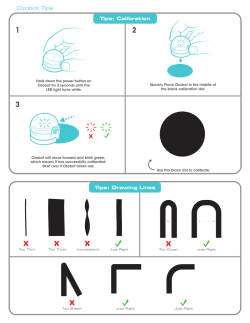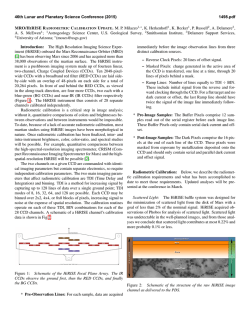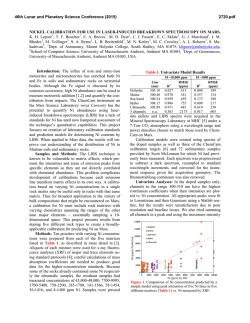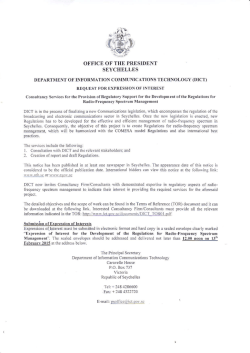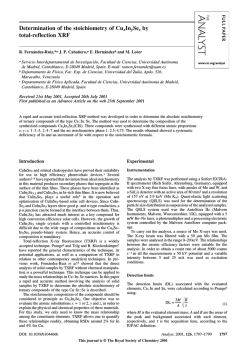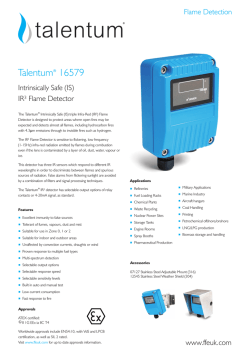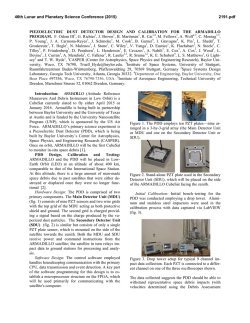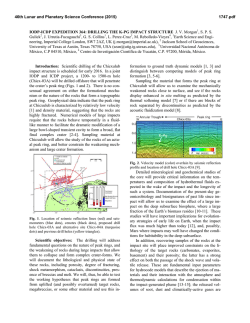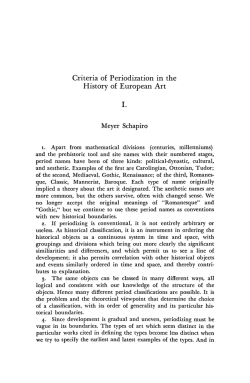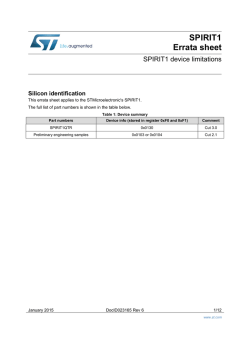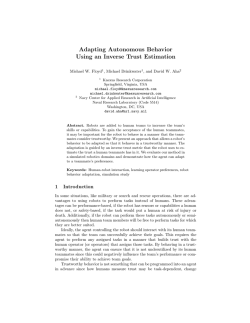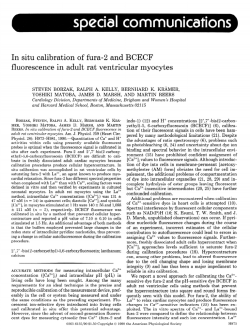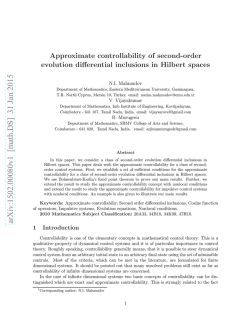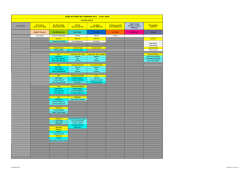
Renaissance®7
Renaissance ® 7 Whole Body Counting Software “The Comprehensive Gamma Spectrometry Solution for Internal Contamination Monitoring Systems.” Renaissance 7 Renaissance is a comprehensive gamma spectroscopy solution for internal contamination monitoring using High and Low Resolution detectors (High Purity Germanium and Sodium Iodide) in a broad spectrum of rapid screening, detailed investigation, and fit for purpose measurement systems. It is easily configured for single or multiple detector measurements using fixed position or automated scanning systems, such as Standup, Chair, and Bed counters. And with a secured system configuration, quality control, customized reporting capability, and an intuitive interface for routine operations and measurements, you can be confident in the quality of your personnel monitoring program! Why Renaissance? Compatibility • • • • Operates in the most common PC Environments – Windows XP, 7, and 8.1 Easily Configurable Reports with Crystal Reports XI Seamless Integration with Microsoft Access and Data Import to IMBA Professional Plus Flexible Configuration Architecture for Small Systems or Large-Scale Network Environments Process Efficiency • • • • Integrated Detector Communication and Motion control Intuitive Operator Interface for Consistent measurement processes Simplified Calibration using Wizards and Interactive Editors High and Low Resolution spectrum analysis capability Defendable Results • • • • Compliance with Industry Standards such as ANSI N42.14 and ANSI N13.30 Quality Control Reports, Trending, and optional Instrument Lock-out on violations Security to limit access to specified functions Operator Startup features ensure proper operation prior to personnel measurements Renaissance 7 New Features to Count On! New! New! New! New! New! New! New! 2 64-Bit Windows 8.1 and 7 Compatibility Crystal Reports Version 11.5 Integrated Controls and Report Templates Maximum Dead Time Limit for Operator Measurements Operator Module Password Protection High Purity Germanium Analysis Engines from GammaVision 7 Compatibility for Multiple Networked Instruments on a Common Database Improved Spectrum Stripping Functionality for Sodium Iodide Analysis Renaissance 7 Renaissance Supervisor Operator System Configuration Module Routine Operation Module Instrument Control Calibration Spectrum Analysis Motor Control Quality Assurance Measurement Systems Standup Counters Chair Counters Scanning Beds Lung Counters 3 Renaissance 7 Intuitive Operator Interface and Expert Mode Renaissance has two distinct interface modules to manage Supervisory/Expert functions from those associated with routine measurement operations. The Supervisor module is used for the initial system configuration, setting Operator permissions, and more detailed spectrum analysis evaluations. This module can also be used for customized measurement processes using automation Jobs similar to ORTEC’s flagship GammaVision application with the ability to analyze High and Low resolution spectra. The Operator module provides a simple and intuitive interface for all routine operations including personnel measurements and instrument checks with minimal experience or training. Key User Interface Features: γ Supervisor Module – Detector Configuration (HPGe and NaI) – Scan Type Configuration based on Detector Type, Analysis and Reporting options, and Motor Controlled Scan settings – Operator Permissions – Full System Calibration – Nuclide Library and Activity Alarm Configurations – Custom Automation processes – Detailed Spectrum Analysis Evaluation for peak fit, interferences, and energy or library adjustment – Editable Attenuation Correction Tables for Muscle and Tissue – Quality Control Configuration and Measurements – MCA Emulation and Spectrum Navigation γ Operator Module – Startup Wizard for routine instrument checks including High Voltage and Gain adjustments, Energy Recalibration, QA Measurements, and Background Correction File generation – Preconfigured Scan Type measurements for identical operation in fixed position or scanning systems configured with a single or multiple high or low resolution detectors – Personnel Information Logging – Count rate Plots for each detector in a multiple detector configuration or by position for scanning systems – Optional Acquisition Extension – Quality Control Measurement and Status – MCA Emulation and Spectrum Navigation γ Security – Optional Password access for Supervisor and Operator modules 4 Renaissance 7 Spectrum Analysis and Reporting Renaissance provides accurate identification and quantification of radioactive material using high and low resolution gamma spectroscopy in personnel monitoring systems. These systems can be supplied in a variety of physical and operational configurations with different combinations of High Purity Germanium and Sodium Iodide detectors that can be analyzed as a group or individually. Analysis reports are highly customizable with Crystal Reports using results stored in a Microsoft Access database, and these reports are easily accessed from the Operator module. When more detailed spectrum analysis evaluation is warranted, the Supervisor module can be used to graphically display peak fits and adjust analysis settings as necessary to optimize results. Key Analysis Features: γ Standards Compliant: ANSI N42.14 and N13.30 γ Application Specific High Resolution Analysis Engines – ENV32: Complex spectra with a large list of possible nuclides – NPP32: Complex spectra with a small or well-characterized nuclide mix – WAN32: Simple spectra with a small list of possible nuclides – GAM32: Simple spectra with a large list of possible nuclides – ROI32: WAN32 with the addition of user-defined regions of interest γ Low Resolution Analysis for Sodium Iodide Screening Systems γ Microsoft Access Database with seamless data integration to IMBA Dose Assessment Software1 γ User-Defined Nuclide Libraries with Key Line, Peak Activity, and MDA Flags γ Graphical Peak Fit and Residuals Display for Expert Analysis Evaluation γ Standard Text Reports and Customizable Reporting with Crystal Reports XI γ Warning and Alarm Limits for routine personnel measurements γ Total Uncertainty Propagation in units of Activity or Percent γ Peak Search Methodology – Library Driven Peak Location – Second Difference method (“Mariscotti”) – User-Defined Regions of Interest γ Analysis Corrections – Nuclide Peak Background/Blank Subtraction – Channel by Channel Background Spectrum Stripping – Partial or Complete Peak Overlap (Deconvolution/Peak Stripping) – During Correction to Time of Uptake – Random Summing Corrections – Gain/Energy Calibration Shift Correction – Chest Wall Thickness Absorption Correction – Optional Directed Peak Fit to force Nuclide Activity in the absence of significant peaks 1 Data integration is available with the ORTEC Import Tool available with IMBA Professional Plus from Public Health England. 5 Renaissance 7 Calibration An accurate calibration is essential for proper peak identification and quantification – particularly for complex spectra with closely overlapping peaks. Renaissance ensures this accuracy using automated or interactive calibration methods along with concise reports and graphical calibration curves for efficient validation. Key Calibration Features: γ Calibrations for High and Low Resolution Detectors – High Purity Germanium, Sodium Iodide, and Others γ Calibration Types – Channel to Energy – Quadratic Fit – Energy to Shape (FWHM) – Quadratic Fit – Energy to Efficiency – Natural Logarithm Polynomial Fit across full energy; or Linear, Quadratic, and Point-to-Point Interpolation Fits for separate high and low energy regions – Peak-To-Total (Cascade Summing) γ Calibration Processes – Automatic Energy Calibration (U.S. Patent No. 6,006,162) – Calibration Wizard – Semi-Automatic and Manual/Interactive – Automation using Job Functions – Automatic Energy Calibration Adjustment during Analysis – Automated Gain Adjustment and Energy Recalibration as Operator Startup Options γ Calibration Reports and Graphic Display Quality Assurance Periodic instrument performance checks are necessary to ensure that the system is operating properly when samples are analyzed. These checks may be required by regulations, standards, or other governing bodies that may audit the results. The minimum performance measures should include validation of the system calibration parameters, limits that define acceptance and a warning when these limits are exceeded. Control charts for trending is also desirable and formally required for some applications. Key Quality Assurance Features: γ ANSI N13.30 and ANSI N42.14 Compliant γ Parameters Monitored – Background Count Rate – Total Source Activity – Total Spectrum to Library Peak Energy Difference – Average Actual to Calibration FWHM Ratio – Average Actual to Calibration FWTM Ratio – Individual Peak Details Available in Database γ Low/High Warning and Minimum/Maximum Violation Limits with Optional Detector Lock-out γ QA Reports and Trend Charts 6 Renaissance 7 Instrument Control The interface between instrumentation and software is provided through the ORTEC CONNECTIONS framework which supports up to 250 detectors across a local network. This application layer encompasses all of the hardware drivers and communication protocols that are necessary for software applications to control the MCB (Multi-Channel Buffer) instruments. Instrumentation controls are accessed through MCB Property pages that are integrated with Renaissance and other standard ORTEC applications. Windows 8.1 and 7 64-bit hardware compatibility is available for all ORTEC instruments that use USB and TCP/IP connectivity. These instruments, as well as other legacy hardware, are also supported with Windows 72 and XP 32-bit operating systems. Instruments that are dependent on a host computer, such as plug-cards or USB devices, can be shared on a network through the MCB Servers running on each computer. This process allows Windows 8.1/7 64-bit computers to operate instruments that are not 64-bit compatible through their 32-bit host. Key Hardware Control Features: γ List Mode Data Acquisition3 γ High Voltage Bias Control γ Course and Fine Gain Adjustment γ Zero and Gain Stabilizer γ SMART-1 Detector functions γ ZDT loss-free counting correction γ Analog and Digital Amplifier Filters γ Automatic and Manual Optimization γ Sample changer control γ Insight® Oscilloscope mode γ Battery Voltage monitoring for portable instruments γ State-of-Health Monitoring γ Acquisition Presents including Real and Live Time, ROI Peak, ROI Integral, Peak Uncertainty, or MDA Further details for hardware functions are provided in the relevant product literature. Motor Control Renaissance enables automated scanning systems through standard Galil Motor Controllers. These scanning systems are calibrated for the start (HOME) position, scan length, scan speed, return speed, and maintenance positions to optimize system operation and ensure that measurements are consistent with the configuration implemented with system calibration. Scanning systems are typically configured at the factory for Turn-Key operation. Adjustments to the position and speed calibrations are then easily implemented at the customer site with the comprehensive Motor Control Setup program included with Renaissance. Instruments using the IPX/SPX protocol require Windows XP. This may be accomplished on a Windows 7 computer using the XP Mode Virtual Machine. Instruments that have a Dual-Port Memory option can take advantage of the DPM-USB to communicate over a USB connection in the Windows 8.1, 7 or XP environments. 3 List Mode Data Acquisition is available for specific instrumentation, such as the DSPec-50/502, DSPec-Pro, and others. 2 7 Renaissance 7 Ordering Information Model Description RENP-BW Renaissance Whole Body Counting Software. Includes standalone or first network copy and binary use license. RENP-NW Renaissance Whole Body Counting Software. Single Use Network Copy. Example: For a three-station network, order one copy of RENP-BW and two copies of RENP-NW. RENP-UW Update from RENP-B32, RENP-BW, or RENP-NW to latest version of Renaissance. RENP-GW Additional Hard Copy Documentation for Renaissance. Additional Software Options A11-B32 CONNECTIONS Programmer’s Toolkit with ActiveX™ Controls. A49-B32 DataMaster Spectrum File Conversion. C53-B32 Nuclide Navigator® III Master Library. Personnel Monitoring Solutions StandFAST II Stand-Up Whole-Body Counter. WBC-200 Sodium Iodide Based Chair with one detector. WBC-200-2 Sodium Iodide Based Chair with two detectors. WBC-200-DFX8530 High Resolution HPGe Based Chair with two detectors and LN2 free cooling. WBC-BSCAN High Resolution HPGe Based Scanning Bed with one detector and LN2 free cooling. WBC-T NaI Based Counter Top Thyroid Screening System with one detector. WBC-LB-2 High Resolution HPGe Based Lung Burden Analysis System with two detectors. WBC-LB-4 High Resolution HPGe Based Lung Burden Analysis System with four detectors. Specifications subject to change 012715 ORTEC ® www.ortec-online.com Tel. (865) 482-4411 • Fax (865) 483-0396 • [email protected] 801 South Illinois Ave., Oak Ridge, TN 37830 U.S.A. For International Office Locations, Visit Our Website
© Copyright 2025
